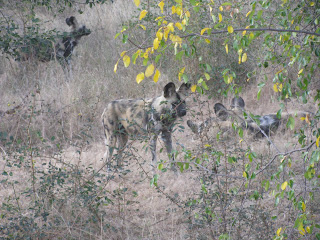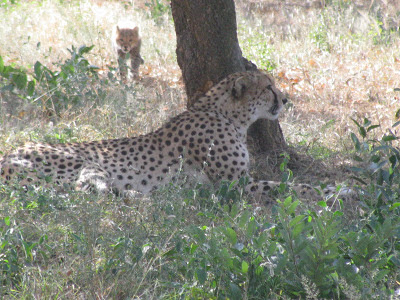Yesterday we returned from a five-day trip to
Kruger National Park and the Hoedspruit Endangered Species Center in South
Africa with over a thousand pictures and some new wildlife experiences.
This trip, we set out to see carnivores, so we
headed to the north of the park where lions are less prevalent and cheetahs,
leopards, and hyenas enjoy the lack of competition while rare antelopes such as
Sable and Hartebeest enjoy the lack of lions eating them. We started in Skukuza
camp, which is still in the south of the park and from there embarked on a
game drive with a guide named Robert.
 The first thing we saw was a breeding
pack of hyenas. Robert explained that hyenas separate their cubs into
age-appropriate groups so that they don’t compete for food, and that a cub will
be fed not only by its mother but also by other members of the pack, practices
to which Robert attributed the very low infant mortality rate among hyenas. Sure
enough, after we had watched and taken photos of this lady, we realized that
there was another nursing mother on the other side of the road with two very
young, all-black cubs who had yet to gain their characteristic spots.
The first thing we saw was a breeding
pack of hyenas. Robert explained that hyenas separate their cubs into
age-appropriate groups so that they don’t compete for food, and that a cub will
be fed not only by its mother but also by other members of the pack, practices
to which Robert attributed the very low infant mortality rate among hyenas. Sure
enough, after we had watched and taken photos of this lady, we realized that
there was another nursing mother on the other side of the road with two very
young, all-black cubs who had yet to gain their characteristic spots.  Robert also noticed something in one of the trees
as we passed by, and when he backed up to show it to us, it turned out to be one
of the most impressive feats of safari-guidery that I have ever seen. In the
dark and while driving, Robert spotted a flap-necked chameleon, a tiny little
fellow who looked so much like the leaves around him that Robert had to point
for ten minutes before everyone in the vehicle had seen it.
Robert also noticed something in one of the trees
as we passed by, and when he backed up to show it to us, it turned out to be one
of the most impressive feats of safari-guidery that I have ever seen. In the
dark and while driving, Robert spotted a flap-necked chameleon, a tiny little
fellow who looked so much like the leaves around him that Robert had to point
for ten minutes before everyone in the vehicle had seen it.
On the fifteenth, we left Skukuza and headed for
Mopani camp, which is named for the famous Mopani tree (in which lives the
Mopani worm, which is considered a delicacy) and is further north in the park.
As we drove up to our camp, we saw teasing symbols—there was a dead impala in a
tree, which can only mean one thing, but the leopard had left his kill and was
likely afraid to return until the humans had stopped guarding his dinner.
 It was a good day for other sightings, though. I
have seen a lot of hippos, but always mostly submerged. On the fourteenth I saw
my first hippos out of water (courtesy of the chilly weather) and the next day
we looked out over the river from the safety of a hide to see a huge breeding herd
basking on a little island that likely disappears during rainy season.
It was a good day for other sightings, though. I
have seen a lot of hippos, but always mostly submerged. On the fourteenth I saw
my first hippos out of water (courtesy of the chilly weather) and the next day
we looked out over the river from the safety of a hide to see a huge breeding herd
basking on a little island that likely disappears during rainy season.
The next day, on a morning drive with a guide
named Amos, we saw a serval and some black-backed jackals, each of which was
too quick to photograph. We also came across this lone female hyena taking seriously
the command of so many parents for their children to finish everything on their
plates. She was gnawing on the last of the skin of an elephant carcass—the elephant
was killed in January when it was struck by lightning, and while I never like
to see an elephant in turmoil, it was amazing how the detrivores continually
made use of the resources available to them.
It was also a good day for birds. We saw a group
of six juvenile ostriches—I saw my first ostrich in the wild on Friday and
couldn’t believe its size even after having seen them in zoos, and even the
young ones were gigantic. But even more exciting than the ostriches were a
smaller and less-known bird which we came across later. In a group of four,
crossing over the road by foot, were the endangered Southern Ground Hornbills.
These large, flighted but mostly ground-dwelling birds are quite rare, and in
fact only 1500 individuals are estimated to exist in South Africa, so we were very
lucky to have seen them.
On the seventeenth, we woke up early
to prepare to leave Kruger for the Hoedspruit Endangered Species Center, and
saw yet another hyena—this one was also nursing, but right in the middle of the
road. She seemed very comfortable with the cars going by and also stopping for
photos.
So we had seen several hyenas,
jackals, and even a serval but none of the majestic big cats. We had seen a
leopard’s kill and also seen a spot in the ground where another leopard had
dragged a kill across the road, and we had heard reports of lions and leopards
and even caught a short glimpse of a leopard in a far-away tree, but sometimes
it’s enough to except the little signs even if you can’t see the actual animal.
As we neared the gate, I noticed a large herd of impala—and of course, why
would impala just stand there, if a predator was nearby? Still, they looked
alert, and right after we passed them I thought I saw something lying in the
riverbed. I asked if we could back up, apologizing in case it was just an
impala and I was making us stop for nothing.
As I have mentioned, I used to
dislike the idea of animals eating one another, but there are two sides to every
story. Leopards have cubs to feed too. Hyenas separate
into nurseries and apparently nurse their pups right in the middle of the road.
So in the end, everybody’s just trying to survive. Sometimes an impala gets
away, and sometimes a leopard gets to eat. I’m just glad he chose that riverbed
to rest in after the hunt.
At the Hoedspruit Endangered Species Center (HESC), the goal is to preserve endangered species such as ground hornbills, African wild dogs, caracals, and servals, but the focus is and has always been on cheetahs.
 The HESC includes breeding programs in which cheeta
The HESC includes breeding programs in which cheeta
And speaking of the wild, the HESC
partners with Kapama Game Reserve, a wild and unregulated piece of land where
animals are free to avoid us seeing them, to arrange game drives there and
occasionally to release animals onto the reserve. We were on one such game
drive and were seeing a lot of common duikers (a small antelope some may
remember from a particularly uneventful night drive of two years ago) when we
topped off our trip with one last huge sighting. In contrast to my unsure
reports of something lying in the riverbed when I saw the leopard, Caleb drew
attention to his find definitively.
“Lion. Lion lion lion.”















